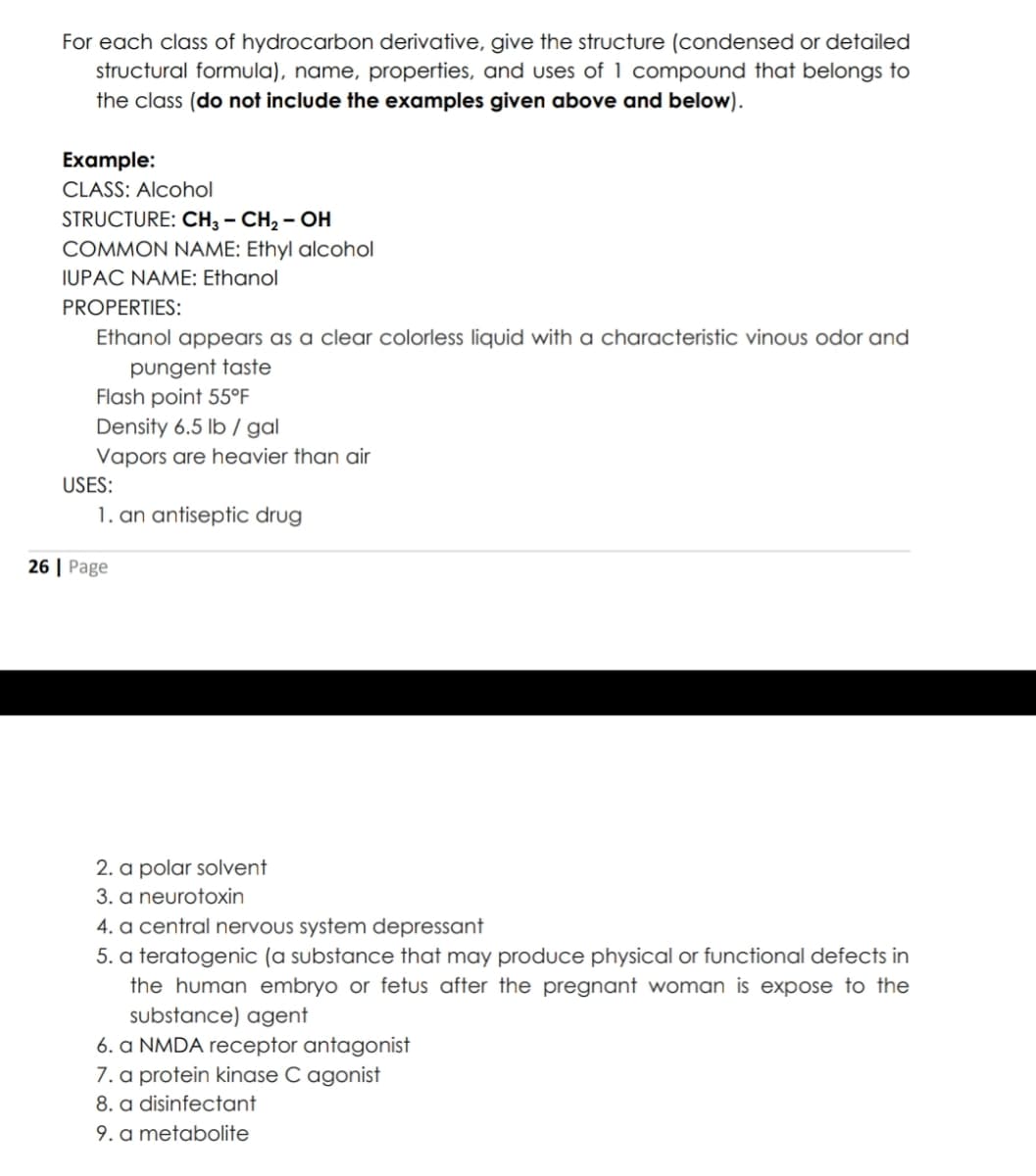For each class of hydrocarbon derivative, give the structure (condensed or detailed structural formula), name, properties, and uses of 1 compound that belongs to the class (do not include the examples given above and below).
For each class of hydrocarbon derivative, give the structure (condensed or detailed structural formula), name, properties, and uses of 1 compound that belongs to the class (do not include the examples given above and below).
Chemistry
10th Edition
ISBN:9781305957404
Author:Steven S. Zumdahl, Susan A. Zumdahl, Donald J. DeCoste
Publisher:Steven S. Zumdahl, Susan A. Zumdahl, Donald J. DeCoste
Chapter1: Chemical Foundations
Section: Chapter Questions
Problem 1RQ: Define and explain the differences between the following terms. a. law and theory b. theory and...
Related questions
Question

Transcribed Image Text:For each class of hydrocarbon derivative, give the structure (condensed or detailed
structural formula), name, properties, and uses of 1 compound that belongs to
the class (do not include the examples given above and below).
Example:
CLASS: Alcohol
STRUCTURE: CH3 – CH, – OH
COMMON NAME: Ethyl alcohol
IUPAC NAME: Ethanol
PROPERTIES:
Ethanol appears as a clear colorless liquid with a characteristic vinous odor and
pungent taste
Flash point 55°F
Density 6.5 lb / gal
Vapors are heavier than air
USES:
1. an antiseptic drug
26 | Page
2. a polar solvent
3. a neurotoxin
4. a central nervous system depressant
5. a teratogenic (a substance that may produce physical or functional defects in
the human embryo or fetus after the pregnant woman is expose to the
substance) agent
6. a NMDA receptor antagonist
7. a protein kinase C agonist
8. a disinfectant
9. a metabolite
Expert Solution
This question has been solved!
Explore an expertly crafted, step-by-step solution for a thorough understanding of key concepts.
Step by step
Solved in 2 steps

Knowledge Booster
Learn more about
Need a deep-dive on the concept behind this application? Look no further. Learn more about this topic, chemistry and related others by exploring similar questions and additional content below.Recommended textbooks for you

Chemistry
Chemistry
ISBN:
9781305957404
Author:
Steven S. Zumdahl, Susan A. Zumdahl, Donald J. DeCoste
Publisher:
Cengage Learning

Chemistry
Chemistry
ISBN:
9781259911156
Author:
Raymond Chang Dr., Jason Overby Professor
Publisher:
McGraw-Hill Education

Principles of Instrumental Analysis
Chemistry
ISBN:
9781305577213
Author:
Douglas A. Skoog, F. James Holler, Stanley R. Crouch
Publisher:
Cengage Learning

Chemistry
Chemistry
ISBN:
9781305957404
Author:
Steven S. Zumdahl, Susan A. Zumdahl, Donald J. DeCoste
Publisher:
Cengage Learning

Chemistry
Chemistry
ISBN:
9781259911156
Author:
Raymond Chang Dr., Jason Overby Professor
Publisher:
McGraw-Hill Education

Principles of Instrumental Analysis
Chemistry
ISBN:
9781305577213
Author:
Douglas A. Skoog, F. James Holler, Stanley R. Crouch
Publisher:
Cengage Learning

Organic Chemistry
Chemistry
ISBN:
9780078021558
Author:
Janice Gorzynski Smith Dr.
Publisher:
McGraw-Hill Education

Chemistry: Principles and Reactions
Chemistry
ISBN:
9781305079373
Author:
William L. Masterton, Cecile N. Hurley
Publisher:
Cengage Learning

Elementary Principles of Chemical Processes, Bind…
Chemistry
ISBN:
9781118431221
Author:
Richard M. Felder, Ronald W. Rousseau, Lisa G. Bullard
Publisher:
WILEY